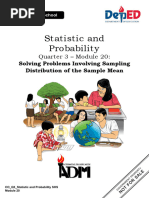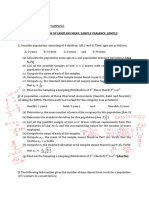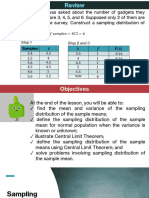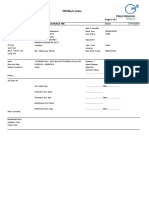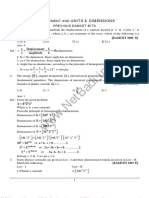0 ratings0% found this document useful (0 votes)
3 viewsProblem-Set_13_Students-copy (1)
The document contains a problem set focused on statistical concepts such as the mean, variance, and standard error related to sampling distributions. It includes multiple-choice questions, calculations for finite population correction factors, and problem-solving exercises involving sample means and standard deviations. The content is designed to assess understanding of key statistical principles and their applications.
Uploaded by
barba.mari2020Copyright
© © All Rights Reserved
Available Formats
Download as DOCX, PDF, TXT or read online on Scribd
0 ratings0% found this document useful (0 votes)
3 viewsProblem-Set_13_Students-copy (1)
The document contains a problem set focused on statistical concepts such as the mean, variance, and standard error related to sampling distributions. It includes multiple-choice questions, calculations for finite population correction factors, and problem-solving exercises involving sample means and standard deviations. The content is designed to assess understanding of key statistical principles and their applications.
Uploaded by
barba.mari2020Copyright
© © All Rights Reserved
Available Formats
Download as DOCX, PDF, TXT or read online on Scribd
You are on page 1/ 2
Problem set
Finding
#13: the
Mean and
TEST I: Read and analyze each statement carefully. Choose the letter that corresponds to the correct answer. Write your
Variance of
answer on the space provided.
_______1. What isSampling
the mean of the sampling distribution of the sample mean?
A. Equal to the population mean B. Greater than the population mean
C. Less than theDistribution
population mean D. Depends on the sample size
_______2. If the population standard deviation is 10 and the sample size is 25, what is the standard error/deviation of
the mean? A. 2 B. 2.5 C. 5 D. 10
_______3. According to the Central Limit Theorem, as sample size increases, the sampling distribution of the sample
mean approaches:
A. A uniform distribution B. A normal distribution C. A binomial distribution D. An exponential distribution
_______4. What effect does increasing the sample size have on the standard error of the mean?
A. Increases it B. Decreases it C. No effect D. Depends on the population size
_______5. If a population has a mean of 50 and a standard deviation of 5, what is the mean of the sampling distribution
of the sample mean for samples of size 16? A. 45 B. 50 C. 55 D. 60
_______6. In the context of sampling distributions, what does the term 'standard error' refer to?
A. The standard deviation of the population B. The standard deviation of the sample
C. The standard deviation of the sampling distribution of the sample mean D. The error made during data collection
_______7. Which of the following is true about the variance of the sampling distribution of the sample mean?
A. It is equal to the population variance B. It is greater than the population variance
C. It is less than the population variance D. It is unrelated to the population variance
_______8. If the sample size increases, what happens to the variance of the sampling distribution of the sample mean?
A. Increases B. Decreases C. Remains the same D. Becomes unpredictable
_______9. For a population that is not normally distributed, the sampling distribution of the sample mean will be
approximately normal if the sample size is:
A. Less than 15 B. At least 30 C. At least 50 D. At least 100
_______10What is the relationship between sample size and the accuracy of the sample mean as an estimate of the
population mean?
A. No relationship B. Larger sample sizes lead to less accurate estimates
C. Larger sample sizes lead to more accurate estimates D. Accuracy is solely dependent on the population size
TEST II: Find the finite population correction factor given the following:
1. N=200 ,n=10
2. N=2000 ,n=10
3. N=400 , n=40
TEST III: Problem Solving
1. Consider all samples of size 5 from this population: 2, 5, 6, 8, 10, 12, 13
A. Compute the mean (μ) and standard deviation (σ) of the population.
B. List all samples of size 5 and compute the mean for each sample.
C. Construct the sampling distribution of the sample means.
D. Calculate the mean of the sampling distribution of the sample means. Compare this to the mean of the
population.
E. Calculate the standard deviation of the sampling distribution of the sample means. Compare this to the
standard deviation of the population.
2. The scores of individual students on a national test have a normal distribution with mean 18.6 and standard
deviation 5.9. At Federico Ramos Rural High School, 76 students took the test. If the scores at this school have
the same distribution as national scores, what are the mean and standard deviation of the sample mean for 76
students?
3. In 2015, the mean return of all common stocks on the Philippine Stock Exchange was 3.5%. The standard
deviation of the returns was about 26%. A student of finance forms all possible portfolios that invested equal
amounts in 5 of these stocks and records the return for each portfolio. This return is the average of the returns of
the 5 stocks chosen. What are the mean and standard deviation of the portfolio returns?
You might also like
- The Notion of Freedom in Krishnamurti and SartreNo ratings yetThe Notion of Freedom in Krishnamurti and Sartre10 pages
- Statistics & Probability Practice Test 3No ratings yetStatistics & Probability Practice Test 33 pages
- Statistics and Probability Module 3 CLT - RPUNO - DigitalNo ratings yetStatistics and Probability Module 3 CLT - RPUNO - Digital17 pages
- Statistics and Probability Quarter 2 - Module 3: For Senior High School100% (1)Statistics and Probability Quarter 2 - Module 3: For Senior High School18 pages
- Chapter Iii: Sampling and Sampling DistributionNo ratings yetChapter Iii: Sampling and Sampling Distribution4 pages
- First Summative Test in Statistics and Probability77% (13)First Summative Test in Statistics and Probability2 pages
- Statistics and Probability Q3 SSLM 6 Artajo 1No ratings yetStatistics and Probability Q3 SSLM 6 Artajo 16 pages
- Finding The Mean and Variance of The Sampling Distribution of Means100% (1)Finding The Mean and Variance of The Sampling Distribution of Means25 pages
- Finding The Mean and The Variance of The SamplingNo ratings yetFinding The Mean and The Variance of The Sampling42 pages
- Summative Test (Sampling Distribution, Known and Unknown Variance, CLT-WPS OfficeNo ratings yetSummative Test (Sampling Distribution, Known and Unknown Variance, CLT-WPS Office2 pages
- Summative Test (Samplng Distribution, Known and Unknown Variance, CLT-WPS OfficeNo ratings yetSummative Test (Samplng Distribution, Known and Unknown Variance, CLT-WPS Office2 pages
- Solving Problem Involving Sampling Distribution of The Sample MeansApril 16 2024No ratings yetSolving Problem Involving Sampling Distribution of The Sample MeansApril 16 202431 pages
- PSUnit III Lesson 2 Finding The Mean - and Variance of The Sampling Distribution of MeansNo ratings yetPSUnit III Lesson 2 Finding The Mean - and Variance of The Sampling Distribution of Means21 pages
- Sampling Distribution of Sample Means Using The Central Limit TheoremNo ratings yetSampling Distribution of Sample Means Using The Central Limit Theorem6 pages
- Stat Prob - Q3 - Week 5 6 - Module 4 - Sampling Distribution Its Mean and Variance - For ReproductionNo ratings yetStat Prob - Q3 - Week 5 6 - Module 4 - Sampling Distribution Its Mean and Variance - For Reproduction26 pages
- Week 5 - Sampling Distribution of Sample Means IINo ratings yetWeek 5 - Sampling Distribution of Sample Means II11 pages
- Stat&Prob Questionnaire Midterm SecondSemesterNo ratings yetStat&Prob Questionnaire Midterm SecondSemester9 pages
- Module 5 Lesson 4 Mean and Variance of The Sampling Distribution of Sample MeansNo ratings yetModule 5 Lesson 4 Mean and Variance of The Sampling Distribution of Sample Means64 pages
- La Danse, A Film by Frederick Wiseman 2009No ratings yetLa Danse, A Film by Frederick Wiseman 20095 pages
- GROUP 1 - Practical Research II - Pre-DefenseNo ratings yetGROUP 1 - Practical Research II - Pre-Defense9 pages
- Line Tracking Robot AUTO-CAD 3D Design Project Exhibition: COMSATS Engineering Robotics CompetitionNo ratings yetLine Tracking Robot AUTO-CAD 3D Design Project Exhibition: COMSATS Engineering Robotics Competition2 pages
- St. Bernard Parish Gov't v. United States, No. 05-1119L (Fed. Cl. May 1, 2015)100% (1)St. Bernard Parish Gov't v. United States, No. 05-1119L (Fed. Cl. May 1, 2015)74 pages
- Medical Center Map - Directions - Hotel Information PDFNo ratings yetMedical Center Map - Directions - Hotel Information PDF3 pages
- Research Trends and Future Perspective in Nonconventional Machining of Fiber-Reinforced Polymers A ReviewNo ratings yetResearch Trends and Future Perspective in Nonconventional Machining of Fiber-Reinforced Polymers A Review44 pages
- 48.lamp Illumination Control System Using Sensor CircuitNo ratings yet48.lamp Illumination Control System Using Sensor Circuit4 pages
- Human Resource Management Assignment Case Study - Job Analysis at Go-ForwardNo ratings yetHuman Resource Management Assignment Case Study - Job Analysis at Go-Forward11 pages
- Training Plan - 101769488 - TP - 61084 - V1No ratings yetTraining Plan - 101769488 - TP - 61084 - V14 pages
- Physical Education and Health 12: 3 Quarter Week 3No ratings yetPhysical Education and Health 12: 3 Quarter Week 36 pages
- Solid waste sampling is a critical process to analyze and manage waste effectivelyNo ratings yetSolid waste sampling is a critical process to analyze and manage waste effectively2 pages
- Works - Design.and - Management.2nd - Edition.jan.2009.ebook DDU100% (1)Works - Design.and - Management.2nd - Edition.jan.2009.ebook DDU522 pages
- (Ebook) The Gospel of Matthew: A Hypertextual Commentary (European Studies in Theology, Philosophy and History of Religions, Book 16) by Adamczewski, Bartosz ISBN 9783631679418, 3631679416 - Quickly download the ebook to read anytime, anywhere100% (2)(Ebook) The Gospel of Matthew: A Hypertextual Commentary (European Studies in Theology, Philosophy and History of Religions, Book 16) by Adamczewski, Bartosz ISBN 9783631679418, 3631679416 - Quickly download the ebook to read anytime, anywhere73 pages






































